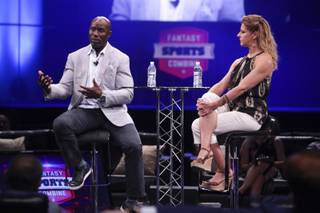Welcome to the era of the “zero running back” strategy.
That is an approach proposed by fantasy football experts Matthew Berry, Liz Loza and others at the inaugural Fantasy Football Combine at the Wynn in Las Vegas this weekend.
The strategy is simple: Don’t draft back-to-back running backs, who for years were the bedrock of fantasy football, in the first two rounds. Opt instead for the safer, pass-catching options.
Last year, an average of five running backs were drafted in the first round of 10-team fantasy drafts, with an average of four going in the second round. That is fewer than ever before, and that trend could continue with the NFL leaning more and more toward the passing game.
From 2000-08, an average of four quarterbacks threw for more than 4,000 yards each year. In the past six seasons, that has risen to more than nine a year.
Experts say that if a valuable running back is on the board, you should still take him. However, some players choose running backs just for the sake of picking one, said Berry, who appears on ESPN’s Fantasy Football Now weekly during the season.
“If you can get one stud running back, you can piece together a second one using the waiver wire,” Berry said during a Q&A session Saturday.
More than 600 people attended the event, put on by entrepreneur Bo Brownstein, to interact with experts in fantasy football as well as former NFL players and coaches including Mike Shanahan, Terrell Davis, Daunte Culpepper, Todd Heap and Brandon Stokley.
“It’s always great to have an autograph or a picture, but to get the chance to pick the brains of these people that you see on a major media platform, or Super Bowl champion-caliber coaches and players, you take so much more away,” Brownstein said.
The “zero running back” strategy also pertains more to players picking in the second half of the draft.
“You really have to grab a big-time wide receiver at picks 6-12 because after that, the drop-off is huge,” said Loza, the founder of TheFantasyFootballGirl.com who was among the panel of experts.
Wide receivers drafted in that range last year include Demaryius Thomas, Dez Bryant, Julio Jones and A.J. Green. Those receivers finished the season ranked second, third, eighth and 21st at their position, respectively.
Compare that with running backs taken in that same range, such as Eddie Lacy, Montee Ball, Marshawn Lynch and Giovani Bernard. Lacy and Lynch ended up as fantasy studs, ranked third and sixth, respectively, but Bernard and Ball had underwhelming seasons, finishing 18th and 89th.
Berry told fantasy football fans, who paid nearly $1,000 each for the two-day VIP experience, to get one stud at each position to hang their hat on, and to do so, they have to take a wide receiver early.
He explained that while the NFL is a passing league, the ball is spread around much more so the stud wide receivers are few and far between. Therefore, selecting one or more early in the draft is crucial.
Stokley, who played 15 seasons at wide receiver in the NFL and won two Super Bowls, played fantasy football in his youth but never participated during his playing days.
“I played fantasy when I was in middle school with all of my dad’s friends,” Stokley said. “I had the No. 1 pick and I took Warren Moon. That was my last full official draft.”
It’s safe to say fantasy football has changed, and Stokley was well aware of it during his final playing years.
“People either loved you or hated you just because of fantasy,” he said. “Not because they were a Denver Broncos fan and you won or lost the game, but you either got them that extra couple points to win, or you didn’t.”
Now Stokley says he is fascinated by the popularity of fantasy football and plans to get more involved.
“I’m going to get back into it,” he said. “It’s a different challenge every week. This is a lot of fun, especially being up there with the best and the brightest in the fantasy industry and learning from those people.”
Berry and ESPN NFL reporter Adam Schefter drew the most fans of perhaps anyone in the room, proving that fantasy football has evolved into a monster of its own.
“I get asked all the time if this is my dream job, and I’m like, “No because when I was dreaming of jobs, this didn’t exist,’” Berry said. “Who thought you could make a living talking about fake sports?”



Join the Discussion:
Check this out for a full explanation of our conversion to the LiveFyre commenting system and instructions on how to sign up for an account.
Full comments policy